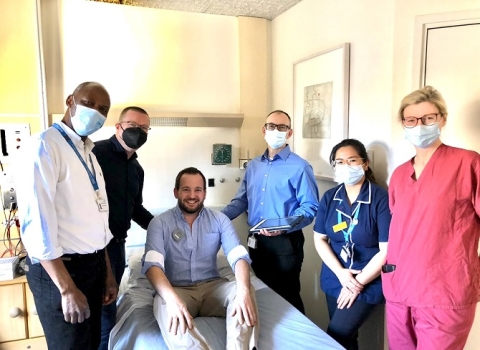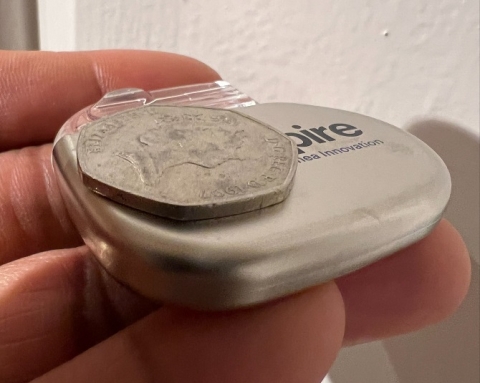Guy’s and St Thomas’ has become the first NHS trust in the UK to use a pioneering implant device to treat a man’s severe sleep apnoea.
Sleep apnoea is when your breathing stops and starts while you sleep. It can lead to more serious problems, such as heart disease, if left untreated.
The condition can sometimes be treated by making lifestyle changes but many people need to use a continuous positive airway pressure device, called a CPAP machine, which gently pumps air into a mask that you wear over your mouth or nose while you sleep.
Matthias Winker, from Reading in Berkshire, suffered with severe sleep apnoea for more than four years and conventional treatments had failed to work. He was one of the first patients to receive hypoglossal nerve stimulation at Guy’s and St Thomas’ to treat the condition.
The 40-year-old said: “Without using a CPAP machine I was having over 40 episodes an hour and would stop breathing for up to 45 seconds at a time. This major disturbance in sleep meant I didn’t feel myself, and left me tired and with low energy throughout the day. The CPAP helped to mitigate the sleep apnoea but wearing a mask for the next four decades didn’t fill me with joy and is inconvenient when traveling.
“In the long term I was at higher risk of having a stroke and heart disease, and a generally poorer quality of life. My wife was really worried and encouraged me to look into other treatment options.”
Hypoglossal nerve stimulation involves implanting an Inspire upper airway stimulation device under the skin in the chest with a lead that goes under the chin.
The device delivers breath-synchronised mild stimulation to the hypoglossal nerve that controls the movement of the tongue and other key airway muscles, allowing the airway to stay open during sleep. It is controlled by a small handheld sleep remote, which the patient turns on before bed and off in the morning when they wake up.
Nothing is visible externally and the implant looks similar to a pacemaker, around the size of two 50p coins.
Matthias, who works for a management consultancy, said: “This therapy has been a tremendous success. I now only have two or three episodes per hour for a few seconds at a time, and then the device jumps in so I can breathe. It took some time to get used to but now it’s comfortable and doesn’t wake me up in the night.”
The father-of-two added: “It’s had absolutely fantastic results – I’m more energised, I have a better quality of sleep, I’m more alert and my concentration is much better. My general mood has also improved because I’m not constantly tired.”
More than 25,000 implants have been fitted worldwide including in the USA, Germany, Netherlands and other European countries. So far three patients have had the device fitted at Guy’s and St Thomas’ and the Trust plans to offer the treatment to more people.
Mr Yakubu Karagama, consultant ear, nose and throat surgeon and laryngologist at Guy’s and St Thomas’, said: “Sleep is very important for physical and mental health and general wellbeing so it’s essential that we are able to help patients with sleep apnoea.
“This treatment isn’t suitable for everyone and many people will benefit from proven, conventional treatments such as a CPAP machine. In a small group of patients who have moderate to severe sleep apnoea, where other treatments have failed, this new device could be a solution. I’m delighted that it is making a huge difference for our patients, and that Matthias has seen such positive results.”
The team are considering referrals from GPs and health professionals for the treatment. You can find more information at the sleep disorder centre.
Contact information
Media enquiries
Phone: 020 7188 5577
Email: press@gstt.nhs.uk


